Navigation
Foundation for Otters
Otters have almost totally disappeared in Western Europe and the number of this species is gradually decreasing today all over Europe. Poaching is on the rise, and populations are fragmented and isolated. Today, the main causes in Western countries are the destruction of wetland habitats and water pollution.
Location:
Hungary
Problem Overview:
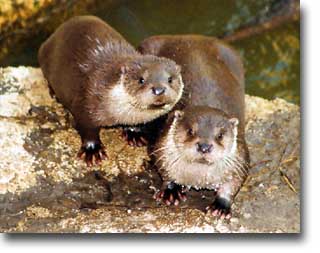 |
Otters have almost totally disappeared in Western Europe and the number of this species is gradually decreasing today all over Europe. Poaching is on the rise, and populations are fragmented and isolated. Today, the main causes in Western countries are the destruction of wetland habitats and water pollution. In Central and Eastern Europe, strong otter populations still exist, but significant deterioration is evident. Hungary plays a key role in saving otters and their habitats because the protection and growth of otter stocks in the Carpathian Basin is the seed for re-establishing otter populations in the West. If protection is well designed in Hungary and Czech Republic, otters will be able to repopulate the West and pressure can be applied to Western governments to restore wetlands and water purity.
There are five different larger isolated groups of otter populations on the European continent:
1. British Isles: the appearance of otters could be described as frequent but in general otters show up rarely in most parts of England.
2. Northern Europe: the number of otters is decreasing the most significantly in this area, mainly on the southern parts.
3. South Western Europe: otters can be found on the western coasts of the Iberian Peninsula and France.
4. Western Europe: Otters have disappeared; small numbers of tiny, isolated groups can be found.
5. Eastern Europe: the most homogeneous population can be found here although the number of otters is decreasing in this region as well.
According to the surveys Pal conducted there are approximately 1500-2000 otters living in Hungary and in the Czech Republic. In Western Europe the whole otter population includes about 700-800 otters.
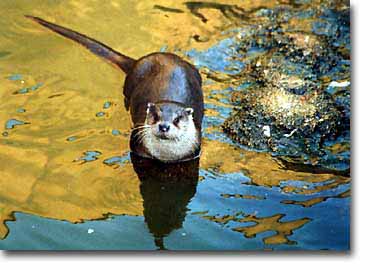 |
The European otter is protected in each country where it appears but some exceptions can be found, e.g. Albania where otter hunting is allowed in winter or Finland and Norway where the species is protected but shooting otters around fishing pounds is legal. We could also mention Ireland, where otters are protected as well, but because of traditional reasons people can get permission for hunting otters with groups of dogs. Or there is Belorussia where otters are not protected. In Bosnia-Herzegovina the protection is seasonal; the species can be hunted in winter.
There are several causes for the decreasing in otter populations, primarily crucial damage to their habitats and environment from growing tourism. Poaching also plays a major role in the disappearance of otters, as do new fishing equipment and methods. We have to mention destructive water management, water pollution and acidization of waters as well.
Otters in Hungary:
Otter appearances are frequent in Hungary. This has two main reasons:
1. The species became protected in 1974.
2. Several hundreds of fishing ponds were created in the past 10-20 years in the south western and eastern parts of Hungary. In the south western regions of Hungary hunting has a long tradition; people earned their living from hunting 300 years ago.
After the 2nd World War everything became owned by the state in Hungary (in 1949) until 1989. Otters could reproduce unhampered. No one cared. But also because communist industrialization resulted in pollution of rivers the number of otters gradually began to decrease in natural wetlands. Environmental protection was equated with general opposition to economic progress. In the 1980s, as the regime began to collapse and a more open political situation evolved, the government prepared an Environmental Law which did not specify punishments for violations and legalized higher pollution levels than in Western countries. This Law was not changed until 1997. From 1989 to 1997, there was no substantive control over the destructiveness of privatization.
Between 1989 and 1993, a nascent environmental movement emerged in Hungary, but it was largely ineffective and waned in the following years due to too much competition for the same limited resources and not enough working together. Each loses its strength in the fight for money and for acceptance by the state and society at large. Hungary therefore remains an exception, even in Central Europe, in its low level of environmental awareness. Privatization and economic growth are often priorities which crowd the environment out of the public’s awareness. Many Hungarian businesses are bitterly opposed to environmental regulations.
The new 1997 Environmental Law is of the highest European standard, but, as it was formulated during the change of governments, a substantial number of its regulations were not enforced because new state leaders (elected in 1998) did not authorize the changes. The state still provides only minimal support for the environment, and even this is gradually dwindling.
Background:
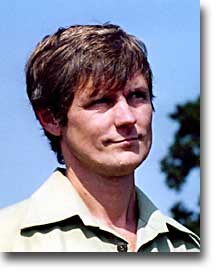 |
Pal and his Foundation for Otters established in 1995 are fighting to raise awareness of environmental protection through his work with otters and wetlands. The Foundation for Otters is the only organization in Hungary which concerns itself specifically with otters and their habitats. Pal has discovered that the endangered otters are an effective symbol of environmental degradation throughout Europe, and can be used to mobilize public support for wetlands conservation, the maintenance of “green corridors,” and the fight against illegal poaching. Pal also focuses on otters because they sit at the top of the food chain and are therefore important indicators of environmental quality.
To achieve the objectives, Gera Pal created a comprehensive program and the first national network based on the involvement of volunteers, children, university students, experts and environmentalists, landowners, fishing and hunting organizations, and politicians. His Foundation for Otters network is uniquely successful in attracting cross-sectoral partnerships and making creative use of volunteer resources, and can provide a blueprint for successful social change movements in Central Europe.
The Foundation for Otters program also features several unique components for wetland and otter protection including:
- national survey methods
- an Otter Park and Ambulance
- conference series
- compensation to fishermen and others for damage caused by otters
- a strong and successful lobby
- and youth education programs.
The Foundation for Otters is grounded in the work of volunteers. A three-member board organizes and manages the different activities and fifty volunteers participate in the Foundation's work throughout the country.
Pal's strategy encompasses the following activities:
1. National surveys: Pal convinced the Ministry of Environment and Regional Development to fund national surveys not only of otter populations, but also of the general condition of wetlands. In 1995-96, the first national survey was carried out by the Foundation for Otters. The second began in 1998 and is still ongoing.
The national surveys have two main objectives:
A. Examining the territorial distribution of the Hungarian otter population: exploring dangers and formulating recommendations for protecting the species;
B. Judging the compensation of damages on fishing ponds caused by otters for wetland owners: identifying the degree and the scale of damage.
Before the first survey began, Pal organized a conference with the participation of university students, local inhabitants, fishermen, hunters, and experts of nationally protected areas. Together, they designed the content of the survey and worked to recruit volunteer support. The conference was a great success, and 90 people volunteered. Fifty of them became a stable core for the Foundation’s work, and they form the heart of the national network.
2. National Network: Pal’s network of volunteers has been expanding steadily. The network will be fully functional by early 2000. In November 1999, he is organizing a conference for the volunteers to work out the network's program for cooperation with the state. The volunteers form a surveillance network that patrols otter habitats two to three times per month and reports environmental changes like deforestation and pollution.
3. Education: With the help of the Budapest Zoo and the Otter Park the Foundation created in Somogy, Pal organizes biology and environmental courses for students throughout the country. The courses in Budapest are attended by school classes from Budapest and the Otter Park is visited by classes from all over Hungary. The Foundation also works with the Environmental Circle of the largest Hungarian university (The Eotvos Lorant Scientific University (ELTE)). Through this circle, he reaches other youth groups and expands his network of young volunteers.
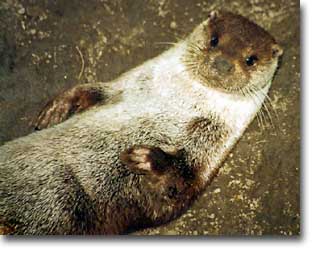 |
4. Strategic Alliances: Pal also works with groups that have traditionally opposed otter protection and wetlands reform, such as wetland landowners whose land is often damaged by otters. To secure their support he has proposed that landowners should get state compensation for damage caused by otters and has succeeded in convincing decision-makers to legalize compensation in the new Environmental Law. Pal is in constant contact with 315 landowners who he informs about the new regulations for compensation. He helps landowners to access this funding. Several thousand such landowners live in Hungary. To be able to reach as many of them as possible, Pal has contacted their professional organizations and cultivated good relationships with them. This was a crucial step: if these organizations accept Pal and his Foundation, landowners cannot refuse to do the same.
5. International Cooperation: Pal is working on the realization of a common Czech-Austrian-Hungarian otter program for 2001-2002 with the aim of creating a green corridor to ensure the expansion of otters to Austria. This program is supported by the Austrian branch of the World Wildlife Fund and Pal wants to involve Slovak and Polish organizations as well. The foundation is in contact with almost every Western European country. Pal established very strong cooperation with Czech and Polish organizations. In 1999, he found new partners in Slovenia and Croatia. Partner organizations exchange information about otter populations and wetlands, ensure mutual help, adapt new methods and programs, and organize reciprocal study visits. Pal has already hosted Austrian, German, Czech, Slovene, and French groups eight times.
6. Otter Park: With the cooperation of the Somogy Provincial Association for Nature Conservation, Pal established the Otter Park in June of 1998 in southwestern Hungary. He created this park with the aim of presenting otters in their natural environment and providing environmental programs for school classes. New construction is underway and several new buildings are being built. Two people manage the daily activities and are paid by the partner organization. In the beginning, the schools of Somogy county visited the park. Today, classes arrive from all over Hungary. Pal is planning to establish professional programs as well like a transportable otter ambulance and a national otter protection center with the cooperation of fishing organizations.
7. Media and conferences: Pal emphasizes the importance of media and public events to enlighten citizens about the significance of environmentalism and the protection of wetlands and otters. He is always active in the media with published articles, interviews on "green" TV, and radio programs. He lectures at national conferences and participates in international conferences. In Hungary, he organized a series of conferences around the issues of environmental education, fishing, and hunting. Each conference was attended by 20-30 participants from very focused social and professional circles, e.g. university students, teachers, fishermen and hunters, experts and environmentalists. These conferences received significant media coverage, and have raised awareness of the otter preservation work throughout the country,
8. Film and Video presentations: Pal has created different kinds of film and video presentations for various groups (school children, university students, experts, etc.). Presentations are 40-45 minutes long. When Pal wanted to reach children, he found that interesting, colorful performances were needed to get their attention. The presentation for children is not only about otters but also about the general protection of the environment and animals. Presentations for experts are more serious and include the problems and solutions of otter preservation and wetland protection.
9. Brochures and Books: The Foundation provides citizens with brochures and books to spread information about the environment, otter protection, legal changes, etc. Some of these include:
- The Protection of Otters
- Together with Otters
- Ideas and Recommendations for the Future Protection of Otters
- State support for Damage caused by Otters, and
- The Long Term Strategy for Otter Protection.
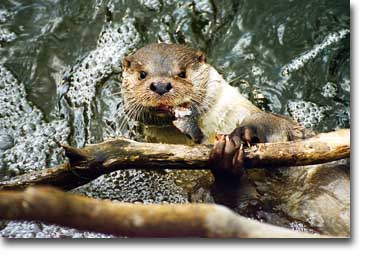 |
The Foundation for Otters sends these to schools, preservation organizations, universities, environmental organizations, libraries, etc.
10. Cooperation with Hungarian Nature Preserves: Pal is in a very close contact with all nine national nature preserves. They exchange methods and programs. These huge organizations ask Pal to conduct expert supervisory work for them.
11. National Database: Pal is planning to compile all of the data collected by the Foundation about otters and the environment and to make it easily accessible through a new database.
12. Lobbying: Pal's lobby work is one of his most important and successful activities. He was asked to participate in the creation of the new Environmental Law, convinced politicians to accept the idea of compensation, and put it into practice. Pal also worked out the methodology for assessing damage as well as its management and compensation. This methodology became the official national structure for damage revision and compensation and Pal's Foundation manages this task.
Photographs courtesy of Pal Gera and Janine Selendy
Submitted by:
Pal Gera
Foundation for Otters
Budapest, Nyirpalota u. 60. VII/29.
1156 Hungary
Tel: 36 1 410 3299
Ashoka profile
Barbara Eros
Ashoka-Hungary
Budapest, Uri u. 49.
1014 Hungary
Tel: 36 1 224 0780
Fax: 36 1 224 0793
Email: h9080ero@ella.hu
Information Date: 1999-11-01
Information Source: Pal Gera
Search
Latest articles
Agriculture
- World Water Week: Healthy ecosystems essential to human health: from coronavirus to malnutrition Online session Wednesday 24 August 17:00-18:20
- World Water Week: Healthy ecosystems essential to human health: from coronavirus to malnutrition Online session Wednesday 24 August 17:00-18:20
Air Pollution
- "Water and Sanitation-Related Diseases and the Changing Environment: Challenges, Interventions, and Preventive Measures" Volume 2 Is Now Available
- Global Innovation Exchange Co-Created by Horizon International, USAID, Bill and Melinda Gates Foundation and Others
Biodiversity
- It is time for international mobilization against climate change
- World Water Week: Healthy ecosystems essential to human health: from coronavirus to malnutrition Online session Wednesday 24 August 17:00-18:20
Desertification
- World Water Week: Healthy ecosystems essential to human health: from coronavirus to malnutrition Online session Wednesday 24 August 17:00-18:20
- UN Food Systems Summit Receives Over 1,200 Ideas to Help Meet Sustainable Development Goals
Endangered Species
- Mangrove Action Project Collaborates to Restore and Preserve Mangrove Ecosystems
- Coral Research in Palau offers a “Glimmer of Hope”
Energy
- Global Innovation Exchange Co-Created by Horizon International, USAID, Bill and Melinda Gates Foundation and Others
- Wildlife Preservation in Southeast Nova Scotia
Exhibits
- Global Innovation Exchange Co-Created by Horizon International, USAID, Bill and Melinda Gates Foundation and Others
- Coral Reefs
Forests
- NASA Satellites Reveal Major Shifts in Global Freshwater Updated June 2020
- Global Innovation Exchange Co-Created by Horizon International, USAID, Bill and Melinda Gates Foundation and Others
Global Climate Change
- It is time for international mobilization against climate change
- It is time for international mobilization against climate change
Global Health
- World Water Week: Healthy ecosystems essential to human health: from coronavirus to malnutrition Online session Wednesday 24 August 17:00-18:20
- More than 400 schoolgirls, family and teachers rescued from Afghanistan by small coalition
Industry
- "Water and Sanitation-Related Diseases and the Changing Environment: Challenges, Interventions, and Preventive Measures" Volume 2 Is Now Available
- Global Innovation Exchange Co-Created by Horizon International, USAID, Bill and Melinda Gates Foundation and Others
Natural Disaster Relief
- STOP ATTACKS ON HEALTH CARE IN UKRAINE
- Global Innovation Exchange Co-Created by Horizon International, USAID, Bill and Melinda Gates Foundation and Others
News and Special Reports
- World Water Week: Healthy ecosystems essential to human health: from coronavirus to malnutrition Online session Wednesday 24 August 17:00-18:20
- STOP ATTACKS ON HEALTH CARE IN UKRAINE
Oceans, Coral Reefs
- World Water Week: Healthy ecosystems essential to human health: from coronavirus to malnutrition Online session Wednesday 24 August 17:00-18:20
- Mangrove Action Project Collaborates to Restore and Preserve Mangrove Ecosystems
Pollution
- Zakaria Ouedraogo of Burkina Faso Produces Film “Nzoue Fiyen: Water Not Drinkable”
- "Water and Sanitation-Related Diseases and the Changing Environment: Challenges, Interventions, and Preventive Measures" Volume 2 Is Now Available
Population
- "Water and Sanitation-Related Diseases and the Changing Environment: Challenges, Interventions, and Preventive Measures" Volume 2 Is Now Available
- "Water and Sanitation-Related Diseases and the Changing Environment: Challenges, Interventions, and Preventive Measures" Volume 2 Is Now Available
Public Health
- Honouring the visionary behind India’s sanitation revolution
- Honouring the visionary behind India’s sanitation revolution
Rivers
- World Water Week: Healthy ecosystems essential to human health: from coronavirus to malnutrition Online session Wednesday 24 August 17:00-18:20
- Mangrove Action Project Collaborates to Restore and Preserve Mangrove Ecosystems
Sanitation
- Honouring the visionary behind India’s sanitation revolution
- Honouring the visionary behind India’s sanitation revolution
Toxic Chemicals
- "Water and Sanitation-Related Diseases and the Changing Environment: Challenges, Interventions, and Preventive Measures" Volume 2 Is Now Available
- Actions to Prevent Polluted Drinking Water in the United States
Transportation
- "Water and Sanitation-Related Diseases and the Changing Environment: Challenges, Interventions, and Preventive Measures" Volume 2 Is Now Available
- Urbanization Provides Opportunities for Transition to a Green Economy, Says New Report
Waste Management
- Honouring the visionary behind India’s sanitation revolution
- Honouring the visionary behind India’s sanitation revolution
Water
- Honouring the visionary behind India’s sanitation revolution
- Honouring the visionary behind India’s sanitation revolution
Water and Sanitation
- Honouring the visionary behind India’s sanitation revolution
- Honouring the visionary behind India’s sanitation revolution

